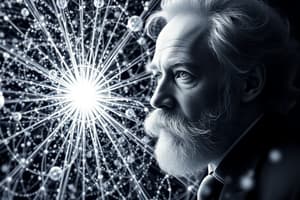Podcast
Questions and Answers
What revolutionary concept did Planck introduce that challenged classical physics and laid the groundwork for quantum theory?
What revolutionary concept did Planck introduce that challenged classical physics and laid the groundwork for quantum theory?
- The concept of energy quanta, suggesting energy is emitted in discrete packets. (correct)
- The idea that atoms vibrate at any frequency.
- The notion that energy is emitted continuously like a wave.
- The principle that energy and frequency are unrelated quantities.
How did Einstein contribute to the validation of Planck's hypothesis about energy quanta?
How did Einstein contribute to the validation of Planck's hypothesis about energy quanta?
- By discovering the electron, which was incompatible with Planck's concept of quanta.
- By developing the theory of relativity, which contradicted Planck's findings.
- By formulating the laws of thermodynamics, which showed Planck's theory was incomplete.
- By explaining the photoelectric effect, demonstrating discrete energy packets during light transmission. (correct)
What is the significance of Planck's constant ($h$) in his radiation law?
What is the significance of Planck's constant ($h$) in his radiation law?
- It provides the value of the smallest possible frequency for electromagnetic radiation.
- It acts as a proportionality constant relating a photon's energy to its frequency. (correct)
- It represents the speed of light in a vacuum.
- It represents the maximum energy of a photon.
What relationship did Planck's Radiation Law define?
What relationship did Planck's Radiation Law define?
What is the Planck length?
What is the Planck length?
What did Paul Dirac's equation famously predict?
What did Paul Dirac's equation famously predict?
Which area of physics did Dirac significantly contribute to based on his studies of Heisenberg's work?
Which area of physics did Dirac significantly contribute to based on his studies of Heisenberg's work?
What prestigious position did Dirac hold at Cambridge University?
What prestigious position did Dirac hold at Cambridge University?
In what year did Paul Dirac and Erwin Schrödinger share a nobel prize?
In what year did Paul Dirac and Erwin Schrödinger share a nobel prize?
How does Planck's theory apply to current technology such as solar power?
How does Planck's theory apply to current technology such as solar power?
Flashcards
Planck's Constant
Planck's Constant
A fundamental constant denoted as 'h' representing quantized energy levels.
Planck's Radiation Law
Planck's Radiation Law
Describes the relationship between an object's temperature and the energy emitted.
Quantum Theory
Quantum Theory
A theory stating energy is emitted in discrete packets called 'quanta'.
Photoelectric Effect
Photoelectric Effect
Signup and view all the flashcards
Planck Length
Planck Length
Signup and view all the flashcards
Planck Time
Planck Time
Signup and view all the flashcards
Paul Dirac
Paul Dirac
Signup and view all the flashcards
Antimatter
Antimatter
Signup and view all the flashcards
Quantum Field Theory
Quantum Field Theory
Signup and view all the flashcards
Energy Quanta
Energy Quanta
Signup and view all the flashcards
Study Notes
Planck's Revolutionary Ideas in Physics
- Planck's work challenged existing physics by proposing that energy is not continuous, but exists in discrete packets called quanta.
- Planck's constant (h) is a fundamental constant representing the smallest unit of energy transfer.
- Planck's radiation law explains the relationship between an object's temperature and the energy it emits in the form of electromagnetic radiation.
- Planck's equation: E = hv (energy equals frequency multiplied by Planck's constant)
- Planck's theory was a cornerstone in the development of quantum theory.
- Planck's work was later validated by Einstein's explanation of the photoelectric effect.
Planck's Quantum Theory
- Planck's work demonstrated that energy transfer is not continuous, but comes in discrete packets (quanta).
- Atoms vibrate at whole-number multiples of a fundamental frequency.
- The relationship between emitted radiant energy and temperature is described by Planck's radiation law.
- Planck's hypothesis revolutionized physics, paving the way for modern technologies.
Planck's Defined Units and Time
- Planck length: the smallest possible unit of length (1.6 x 10-35 meters).
- Planck time: the shortest measurable unit of time (5 x 10-43 seconds)
- Planck's units are the smallest measurable quantities for time and length relevant to particle physics.
Paul Dirac and Antimatter
- Dirac developed the Dirac equation to predict the existence of antimatter particles.
- Dirac's equation accurately describes antimatter particles with identical properties to matter particles but opposite electric charge.
- Dirac's work advanced quantum field theory, a branch of physics related to quantum mechanics.
- His contributions earned him his Nobel Prize.
Studying That Suits You
Use AI to generate personalized quizzes and flashcards to suit your learning preferences.





